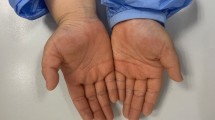Abstract
In order to study allergic people responding to daily changes in pollen concentrations, we compared personal diary data on allergic symptoms and the use of allergy medicines to daily pollen counts during the two unequal alder and birch pollen seasons of 2009 and 2010. Almost 90% of the 61 subjects with physician-diagnosed birch pollinosis developed conjunctival, nasal or other symptoms during the peak birch pollination. Most subjects (95%) also reported symptoms during the alder pollination. Despite a delay between the most severe symptoms and the pollen peaks and the increased risk of allergy symptoms between the alder and birch pollen peaks at much lower pollen concentrations, the number of subjects with allergy symptoms correlated with the daily pollen concentrations in both years (r 09 = 0.35, r 10 = 0.36, p < 0.01). The positive correlation was even stronger (r 09 = 0.69, r 10 = 0.74, p < 0.001) in relation to the cumulative sum of daily concentrations. The use of allergy medicines precisely followed the abundance of allergy symptoms in both years (r 09 = 0.96, r 10 = 0.70, p < 0.001). We conclude that there is a fair correlation between the daily allergy symptoms and the particular pollen concentrations, but the risk of developing symptoms at low, moderate and high concentrations is affected by the progression of the pollen season.




Similar content being viewed by others
References
Burr, M. L., Emberlin, J. C., Treu, R., Cheng, S., & Pearce, N. E. (2003). Pollen counts in relation to the prevalence of allergic rhinoconjunctivitis, asthma and atopic eczema in the International Study of Asthma and Allergies in Childhood (ISAAC). Clinical and Experimental Allergy, 33, 1675–1680.
Buters, J. T. M., Kasche, A., Weichenmeier, I., Schober, W., Klaus, S., Traidl-Hoffman, C., et al. (2008). Year-to-year variation in release of Bet v 1 allergen from birch pollen: Evidence for geographical differences between West and South Germany. International Archives of Allergy and Immunology, 145, 122–130.
Buters, J. T. M., Weichenmeier, I., Ochs, S., Pusch, G., Kreyling, W., Boere, A. J. F., et al. (2010). The allergen Bet v 1 in fractions of ambient air deviates from birch pollen counts. Allergy, 65, 850–858.
Canonica, G. W., & Compalati, E. (2009). Minimal persistent inflammation in allergic rhinitis: Implications for current treatment strategies. Clinical and Experimental Immunology, 55, 260–271.
D’Amato, G., Spieksma, F. T., Liccardi, G., Jager, S., Russo, M., Kontou-Fili, K., et al. (1998). Pollen-related allergy in Europe. Allergy, 53, 567–578.
Emberlin, J., Mullins, J., Corden, J., Millington, W., Brooke, M., Savage, M., et al. (1997). The trend to earlier Birch pollen seasons in the UK: A biotic response to changes in weather conditions? Grana, 36, 29–33.
Eriksson, N. E., & Holmen, A. (1996). Skin prick tests with standardized extracts of inhalant allergens in 7099 adult patients with asthma or rhinitis: Cross-sensitizations and relationships to age, sex, month of birth and year of testing. Journal of Investigational Allergology & Clinical Immunology, 6, 36–46.
Grote, M., Valenta, R., & Reichelt, R. (2003). Abortive pollen germination: A mechanism of allergen release in birch, alder, and hazel revealed by immunogold electron microscopy. The Journal of Allergy and Clinical Immunology, 111, 1017–1023.
Holmquist, L., Ekebom, A., Kübler, K. A., & Vesterberg, O. (2005). Airborne birch and oak pollen grains and birch pollen allergens at a common sampling station in Stockholm. Grana, 44, 104–107.
Jantunen, J., & Saarinen, K. (2009). Intrusion of airborne pollen through open windows and doors. Aerobiologia, 25, 193–201.
Kämpe, M., Stålenheim, G., Janson, C., Stolt, I., & Carlson, M. (2007). Systemic and local eosinophil inflammation during the birch pollen season in allergic patients with predominant rhinitis or asthma. Clinical and Molecular Allergy, 5, 4.
Matthiessen, F., Ipsen, H., & Lowenstein, H. (1991). Pollen allergens. In G. D’Amato, F. Spieksma, F. Th, & S. Bonini (Eds.), Allergenic pollen and pollinosis in Europe (pp. 36–45). Oxford: Blackwell Scientific Publications.
Pehkonen, E., & Rantio-Lehtimäki, A. (1995). Sensitivity of IgG-ELISA for detecting airborne pollen antigens of Betulaceae. Grana, 34, 350–356.
Rantio-Lehtimäki, A., Viander, M., & Koivikko, A. (1994). Airborne birch pollen antigens in different particle sizes. Clinical & Experimental Allergy, 24, 23–28.
Saarinen, K., Jantunen, J., & Haahtela, T. (2011). Birch pollen honey for birch pollen allergy–A randomized controlled pilot study. International Archives of Allergy and Immunology, 155, 160–166.
Taylor, P. E., Flagan, R. C., Miguel, A. G., Valentaw, R., & Glovsky, M. M. (2004). Birch pollen rupture and the release of aerosols of respirable allergens. Clinical & Experimental Allergy, 34, 1591–1596.
Tilles, S. A., & Bardana, E. J. (1997). Seasonal variation in bronchial hyperreactivity (BHR) in allergic patients. Clinical Reviews in Allergy and Immunology, 15, 169–185.
Traidl-Hoffmann, C., Kasche, A., Jakob, T., Huger, M., Plötz, S., Feussner, I., et al. (2002). Lipid mediators from pollen act as chemoattractants and activators of polymorphonuclear granulocytes. The Journal of Allergy and Clinical Immunology, 109, 831–838.
Viander, M., & Koivikko, A. (1978). The seasonal symptoms of hyposensitized and untreated hay fever patients in relation to birch pollen counts: Correlation with nasal sensitivity, prick tests and RAST. Clinical Allergy, 8, 387–396.
Wang, Q., Nakamura, S., Lu, S., Xiu, G., Nakajima, D., Suzuki, M., et al. (2011). Release behavior of small sized daughter allergens from Cryptomeria japonica pollen grains during urban rainfall event. Aerobiologia. DOI: 10.1007/s10453-011-9212-4.
Author information
Authors and Affiliations
Corresponding author
Rights and permissions
About this article
Cite this article
Jantunen, J., Saarinen, K. & Rantio-Lehtimäki, A. Allergy symptoms in relation to alder and birch pollen concentrations in Finland. Aerobiologia 28, 169–176 (2012). https://doi.org/10.1007/s10453-011-9221-3
Received:
Accepted:
Published:
Issue Date:
DOI: https://doi.org/10.1007/s10453-011-9221-3




